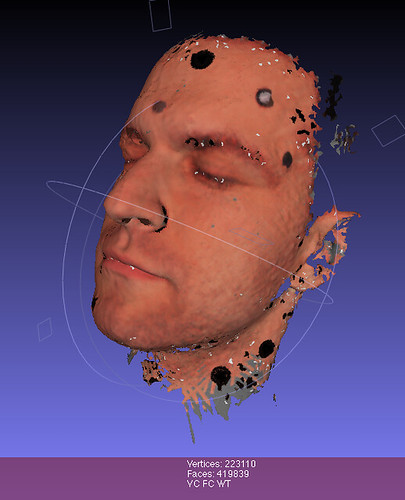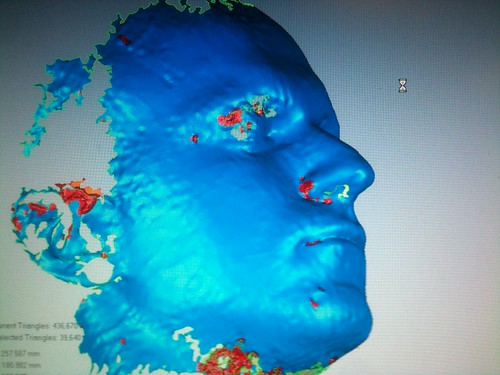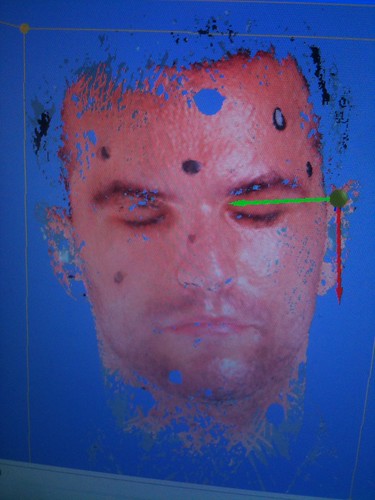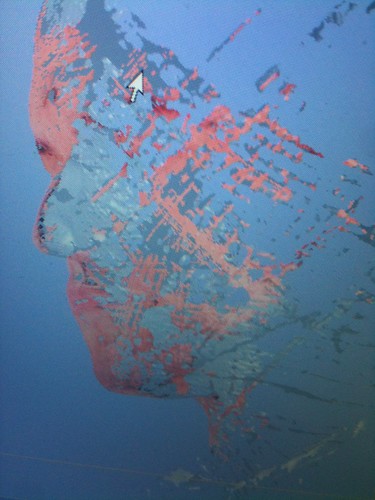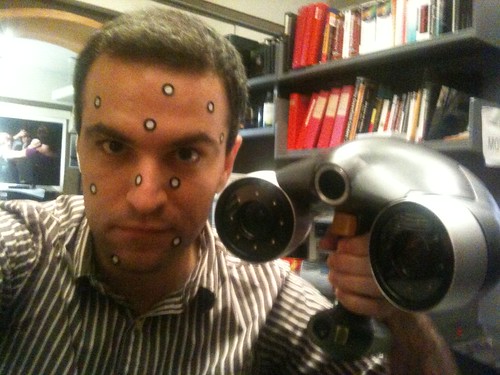The light edged into view through my tightly shut eyelids. Waves of stippled white pulsed down towards a corona of laser pink before spilling into a liquid bokeh of soft hexagons. I tried to relax my eyelids against the involuntary movements of my pupils, briefly seeing strands of eyelash catch the light when my eyes threatened to open. I could feel the light on my skin as heat even though I knew the LEDs were dead cool. It swept across the center of my vision to settle somewhere low and right, crystalline geometries floating where my sight settled back to black.
The intensity wavered momentarily. I felt the invisible presence of the tech moving soundlessly somewhere in front of me. I listened to the chorus of humming coming from the printer room, a cacophony of mistuned exhaust fans and above it someone whistling semi-tunelessly.
How long had the scan been underway? The tech took seemingly endless pauses, saying nothing, the light of the scanner off or at least off my face. Just as I’d gird myself to open my eyes, the light would flare up and I’d squeeze them shut feeling the dots on my face shift subtly, their edges peeling away from the peaks of folding flesh. I straightened my back and willed my facial muscles to stay still. The flickering of the light made my eyes jitter involuntarily beneath their lids in a parody of REM sleep.
The tech had explained that the scanner could find the calibration dots, knew where they should be. So even if I shifted position it would be able to reassemble my face. If I moved too much, he said, the scanner would fail to put my face back together, leaving it a blend between the two expressions. I fought the urge to grimace, arch my eyebrow, or feel the itch tickling the side of my mouth.
I listened to the muffled sound of the shop manager berating a junior employee about links on a website. The light shut off again with finality. I relaxed and felt the inside of my face unstick from my skull as the muscles slackened.
I opened my eyes.
The tech was standing with his back to me, hunched over a laptop suspended on a chest-high shelf, his broad back a vivid swath of red across my vision as I blinked my eyes clear. His short sleeves revealed faded tattoos on his right wrist as it hovered over the computer.
“It will take a few minutes to process,” he said. “I wasn’t setup for you and this is the first time we’ve tried the full resolution.”
I stood up and peered past his shoulder at the screen. Thin strokes outlined a black cube over a pale blue background. The cube enclosed what looked like a picture of my face in three-quarter profile. My skin was rubbery and dead, shiny with flat reflections from a light that seemed to press in from all sides. It was mottled with what looked like lesions where the system had failed to fully fold the tracking dots back into the surrounding texture. A death mask.
The tech tilted my head down, bringing my forehead into closer view. At the hairline my forehead dissolved into a skerry of varicolored slashes, the lines of data from the laser forming a riotous coastline against the calm blue below. The tech toggled the texture on and off. Without it, my head was reduced to a dully gray, revealing the raw geometry. He rotated and probed as he ran various operations designed to close the thousands of small holes in my neck, whose lower reaches sprouted enough extending tendrils to make the whole assemblage resemble the lost android head of Philip K. Dick. My cheeks revealed a distorting ripple that the tech smoothed with a virtual brush.
Finishing cleanup operations the tech demonstrated how his new software could shell my head — expanding it from a volumeless surface into a thin solid. With some of the most fragile fringes paired away, this could even be printed in powder or resin by one of the humming behemoths in the next room. Samples of prints littered the shelves around the office: intricate assemblages in honey-colored translucent resin, a planetary gear and a working wrench in a strangely heavy dark dray plastic, and a few small heads and insects in the gleaming white of the powder printer.
Imagining my shelled face printed in this last material completed its imaginary transformation into a death mask. I could see the object like something out of Greek ritual, the third theatrical mask after comedy and tragedy: mundanity.
After a few more minutes at the controls, which for the first time in the session he punctuated with polite chatter about the sudden storm outside, the tech finished his work. He handed me back my key drive with the results of the scan. The full geometry both cooked and raw. The colored texture file which un-peeled the sides of my face to lay flat, like the skin of a Yakuza gangster mounted to display its tattoos in the Tokyo University museum.
I took the drive, thanked him, and turned to leave. A few steps on, I stopped at the door and looked back, suddenly confused, possessed by a strong sensation that I was somehow shoplifting, that I’d forgotten to pay some unasked cost. The tech disappeared around a sterile mounting table and back into his office, out of view. I turned and continued out and down towards the street. I pushed through a throng of students and out towards the rotating doors. I felt light, sure I’d lost something, but clueless as to what.
Note: this brief story attempts to describe an experience I had earlier this week having my face scanned with the new ZScanner 700 CX 24-bit color laser scanner at NYU’s Advanced Media Studio. Below I present a number of pictures captured in the course of that experience. While I think these images have a powerful visual impact, part of what I wanted to capture in the story was the profound non-visual nature of the experience. It was an experience not of seeing, but of being seen. Hence my decision to present these images at the bottom of this post rather than interspersed throughout. There’s an increasing body of writing that looks at these New Aesthetic or Robot-Readable World images in order to analyze their visual qualities in an attempt to understand how these new seeing technologies picture us. Here instead I wanted to capture an intimate experience of being the conscious subject of this new form of vision — in this case even when our eyes are literally closed in the process. I found the experience simultaneously meditative, reflective, and mildly alienating. I hope this piece of writing communicates some sense of that. Enjoy the pictures. I do.

